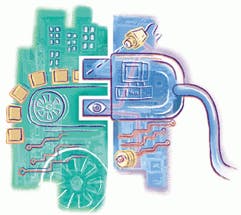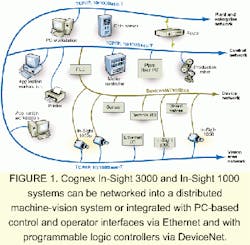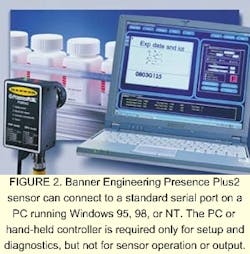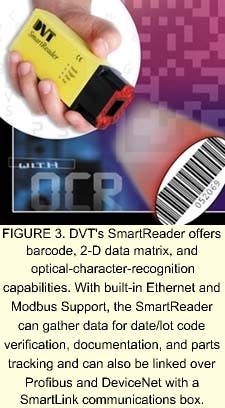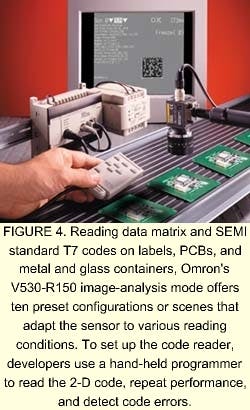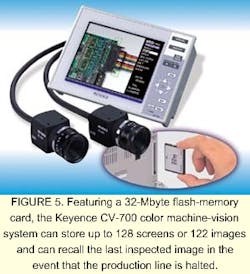Machine vision moves toward plug-and-play
MACHINE-VISION SYSTEMS
Market-aggressive companies are introducing machine-vision systems that can be easily and rapidly programmed to handle less-demanding tasks.
By Andrew Wilson,Editor
Thanks to the advent of open computing standards such as the PCI bus and emerging digital camera interfaces such as Camera Link, developers of machine-vision systems can tailor their platforms to meet the needs of several markets. Although some applications, such as web inspection and digital radiology, require custom-tailored systems using off-the-shelf cameras, digitizers, and displays, others call for machine-vision systems to perform less-demanding tasks, such as barcode recognition.
Interestingly, numerous OEM component vendors have yet to address this trend. However, a number of companies emerging from the machine automation industry see the vision industry as a market opportunity for their product mix. Rather than integrate traditional cameras, frame grabbers, and software, these companies are introducing point products—machine-vision systems that can be programmed and deployed rapidly.
In preparing such systems, machine-vision designers become tied to a specific, often closed, platform, in which camera, image processor, user interface, and image-processing software are all proprietary. Despite this obstacle, integrated vision functions such as pattern matching, recognition, and pass/fail analysis allow such systems to be ready in weeks rather than months.
SMART SYSTEMS
In the past, many machine-vision systems developed as stand-alone platforms featured proprietary cameras, image-processing hardware, software, and input/output (I/O) devices. For example, Cognex Corp. (Natick, MA), with the introduction of its In-Sight vision sensor and Nintendo-like interface, provided systems developers with such a proprietary system. But systems integrators demanded more than easier programming tools. Many wanted a means to network machine-vision systems within an integrated factory environment.
In response, Cognex introduced two units—an upgrade of In-Sight, the In-Sight 3000, which adds Ethernet network capabilities to the functions of the In-Sight 2000, and the In-Sight 1000 intelligent camera. As a stand-alone device, the In-Sight-1000 is similar to the In-Sight 2000 and 3000 vision engines in using an embedded PowerPC. To reduce costs, however, no digital-signal processor performs image-processing functions. Instead, all the software tools, including Cognex's PatFind and spreadsheet-driven software, are computed using the PowerPC.
The Ethernet capabilities of the In-Sight 3000 and In-Sight 1000 devices allow networking to form a distributed machine-vision system. With a library of vision tools, the In-Sight 3000 helps developers configure applications using a vision spreadsheet interface. Additionally, these systems can be integrated with PC-based control and operator interfaces via Ethernet and with programmable logic controllers (PLCs) via DeviceNet (see Fig. 1).
Another company also has implemented vision-based networking. The Banner Engineering (Minneapolis, MN) PresencePlus inspection system targets machine-vision developers. In operation, the system captures 512 x 384 x 8-bit gray-scale images, converts them to black-and-white pixels, and renders pass/fail inspection judgements. System setup programming is also accomplished using a hand-held controller with a built-in liquid-crystal-display screen, which offers programming options, monitoring options, captured images, and diagnostics during sensor operation.
In its latest design, the Presence Plus2 sensor can be connected to a standard serial port on a PC running Windows 95, 98, or NT. The PC or hand-held controller is required only for setup and diagnostics, but not for sensor operation or output. Offering the same features as PresencePlus, the Plus2 can be used with a PC to store setup inspection configurations and images. Viewing full-resolution 512 x 384-pixel binary or 256 gray-scale images allows developers to set lighting and sensor positioning via the PC monitor (see Fig. 2).
The F10 gray-scale, pattern-matching machine-vision sensor from Omron Electronics Inc. (Schaumburg, IL) also features RS-232/RS-422 communications that let a remote PC, PLC, or supervisory control and data-acquisition (SCADA) system control the vision sensor. The RS-232/RS-422 communications capabilities can network multiple F10s, enabling a single source to upload or download configurations to any sensor. The Omron F10 detects patterns (rather than spots, as photoelectric sensors do) for applications such as pattern matching, label placement, and printing verification and conformity checks.
BARCODE READERS
A year ago, DVT Corp. (Norcross, GA) introduced a range of vision sensors that can monitor inspections without a PC. By transferring images via Ethernet, several SmartImage sensors can be monitored from a single location. Moreover, multiple images from different SmartImage sensors can be viewed simultaneously. These sensors also feature optional Profibus or DeviceNet connectivity. Sensor applications can be stored and transferred over Ethernet, and failed images can be transferred via Fieldbus or TCP/IP Ethernet for later review and analysis.
Recently, DVT has upgraded the SmartImage sensor and released a targeted product called SmartReader, which offers barcode, two-dimensional (2-D) data matrix, and optical-character-recognition capabilities (see Fig. 3). With built-in Ethernet and Modbus networking support, SmartReader can gather data for date/lot code verification, documentation, and parts tracking. The sensor also can be linked over Profibus and DeviceNet with a SmartLink communications box. Aided by optics, illumination, and support software, SmartReader can locate vertical and horizontal positions and track up to 360° of rotation.
Other companies have realized this market opportunity. As it rolled out its In-Sight 1000 series, Cognex also announced the In-Sight 1010, a self-contained, Ethernet-ready machine-vision sensor for reading 2-D matrix and linear barcodes. Combining a vision camera and a processor, the In-Sight 1010 can read codes that are poorly formed, distorted, or degraded at speeds to 50 codes/s.
By acting as an Ethernet node, the sensor shares identification information with other networked locations throughout a factory and can be configured, maintained, and managed from a remote site. As it reads 2-D codes, the In-Sight 1010 also provides verification metrics to monitor how well the marking equipment is functioning. Supported code formats include data-matrix ECC200, Code 3-of-9, Interleaved 2-of-5, Code 128, UPC, UPC/EAN, PostNet, and Planet Code.
Omron's latest V530-R150 2-D code reader also detects data matrix and SEMI standard T7 codes on labels, printed-circuit boards, and metal and glass containers (see Fig. 4). The V530-R150 image-analysis mode offers ten preset configurations or scenes that adapt the sensor to different reading conditions. To set up the code reader, developers use a hand-held programmer to read the 2-D code, repeat the performance, and detect errors in the code. The V530-R150 features an RS-232C interface and I/O to Omron's PLCs, operator interfaces, and power supplies.
JUST ADD COLOR
Although many machine-vision systems are used for gray-scale images, other classes of applications, especially in food manufacturing, mandate the use of color imaging. In the past, many frame-grabber and image-processing vendors have been unsuccessful in providing products for color machine-vision applications. It now seems that the demands for a reliable color vision solution has been directed to machine-vision-system vendors.
Able to detect and measure as many as eight colors simultaneously, Omron's latest color machine-vision system, the F400, can be configured to convert a color image into 256 gray-scale levels to analyze and measure differences in the isolated color image, even under fluctuating lighting conditions. Featuring many of the same measurement functions as the Omron F150-2, such as a degree of defect tool and edge and position compensation, the system can be connected to an Omron PLC via an RS-232C interface.
Keyence Corp. of America (Woodcliff, NJ) CV-700 vision system also provides color recognition and detection (see Fig. 5). Featuring a 32-Mbyte flash-memory card, it can store as many as 128 screens or 122 images. It also can recall the last inspected image, in the event that the production line is halted or needs to be restarted under the same inspection conditions.
Using the CV-700 controller, system developers can store up to eight screen images in the system's separate built-in memory. During operation, up to eight images of targets that fail the preset test criteria can be automatically saved in the controller. Additionally, the CV-700 stores the setup menu for restoring previous settings, including such parameters as camera focus and brightness adjustment.
Its pattern-search capabilities are enhanced by a custom-built application-specific integrated circuit. This chip provides 360° rotation and subpixel measurements for image search and pattern recognition. A system center-of-gravity algorithm enables consistent image rotation through a full 360° for pattern matching with an average pattern search time of 0.1 s. Additional features include subpixel measurement, illumination adjustment, and normalized correlation against image-illumination changes, an analog output for data recording, and a menu-driven interface.
CAMERA CHALLENGES
Billing their products as smart vision systems, manufacturers such as Cognex, Keyence, and Banner have developed products that integrate sensors, operating systems, and networking into easy-to-configure platforms. More important, such products integrate image-processing and machine-vision algorithms with user-friendly interfaces, allowing developers to test their applications in days instead of weeks.
Interestingly, less than two years ago, many industry analysts predicted that such products would be developed by smart-camera manufacturers, rather than machine-vision-system vendors. And while companies such as DS GmbH (Stuttgart, Germany), Pulnix America Inc. (Sunnyvale, CA), and Wintriss Engineering (San Diego, CA) have introduced products that combine sensor, processor, and software, they are priced slightly higher than those offered by systems vendors. Perhaps, companies need to take a systems approach by front-ending their designs with plug-and-play interfaces to gain wider acceptance.
COMPANY INFORMATION
Due to space limitations, this Product Focus does not include all of the manufacturers of the described product category. For information on other suppliers of machine-vision systems, see the 2001 Vision Systems Design Buyers Guide (Vision Systems Design, Feb. 2001, p. 62).
Banner Engineering
Minneapolis, MN 55441
Web: www.baneng.com
Cognex Corp.
Natick, MA 01760
Web: www.cognex.com
DS GmbH
Stuttgart, Germany
Web: www.ds-gmbh.com
DVT Corp.
Norcross, GA 30093
Web: www.dvtsensors.com
Keyence Corp
Woodcliff Lake, NJ
Web: www.keyence.com
Omron Electronics Inc.
Schaumburg, IL 60173
Web: www.omron.com/oei
Pulnix America Inc.
Sunnyvale, CA 94089
Web: www.pulnix.com
Wintriss Engineering Corp.
San Diego, CA 92121
Web: www.weco.com

